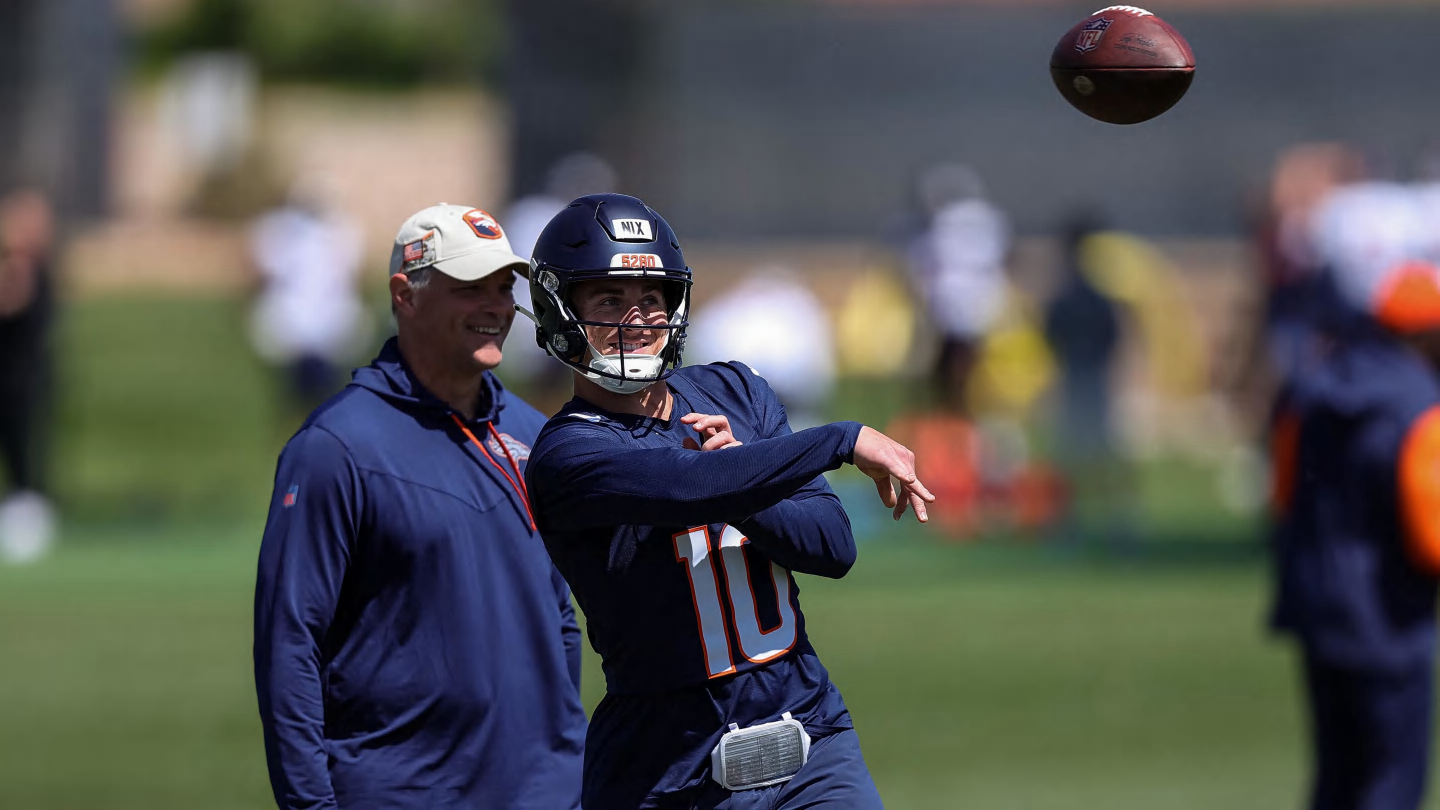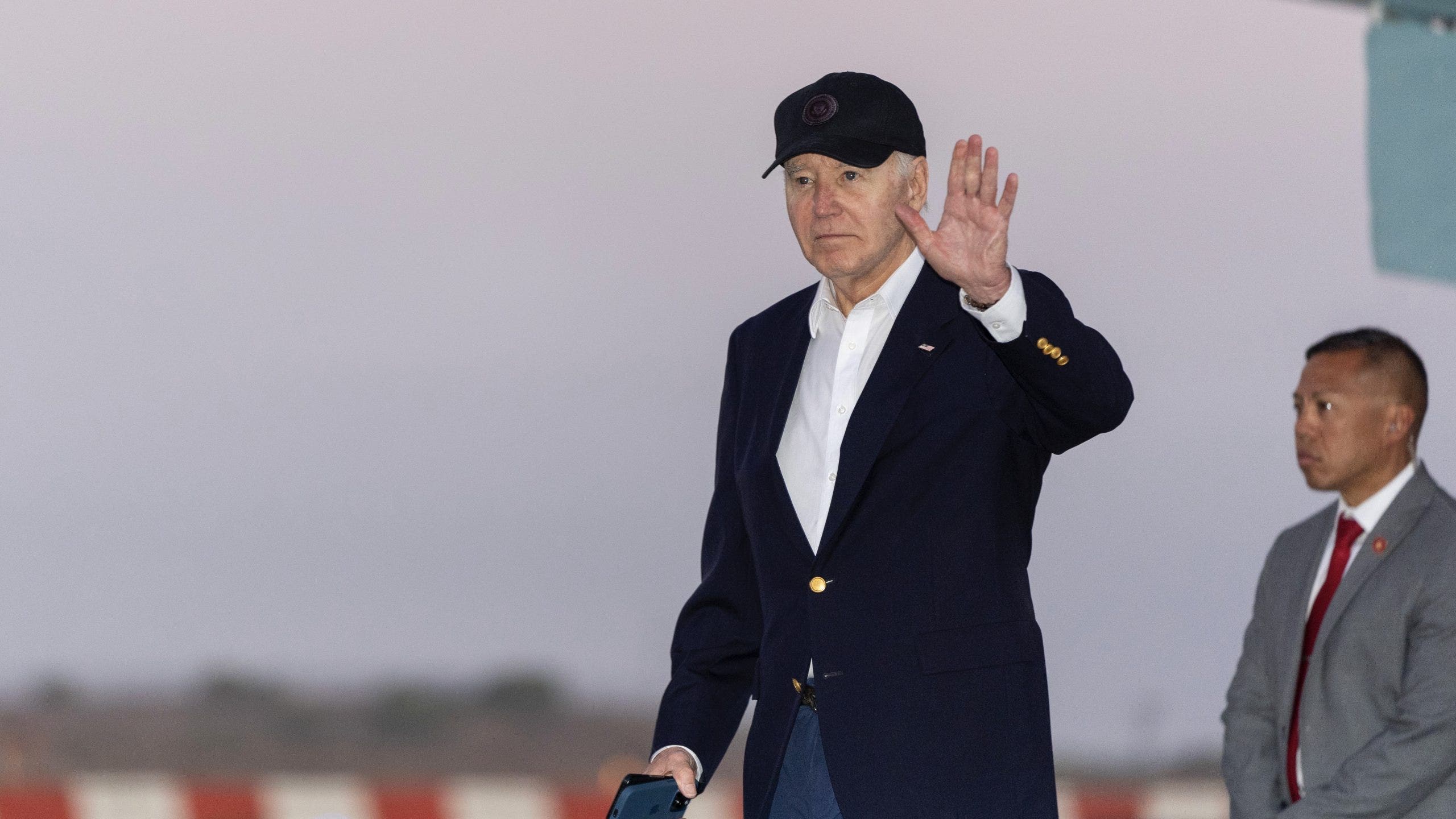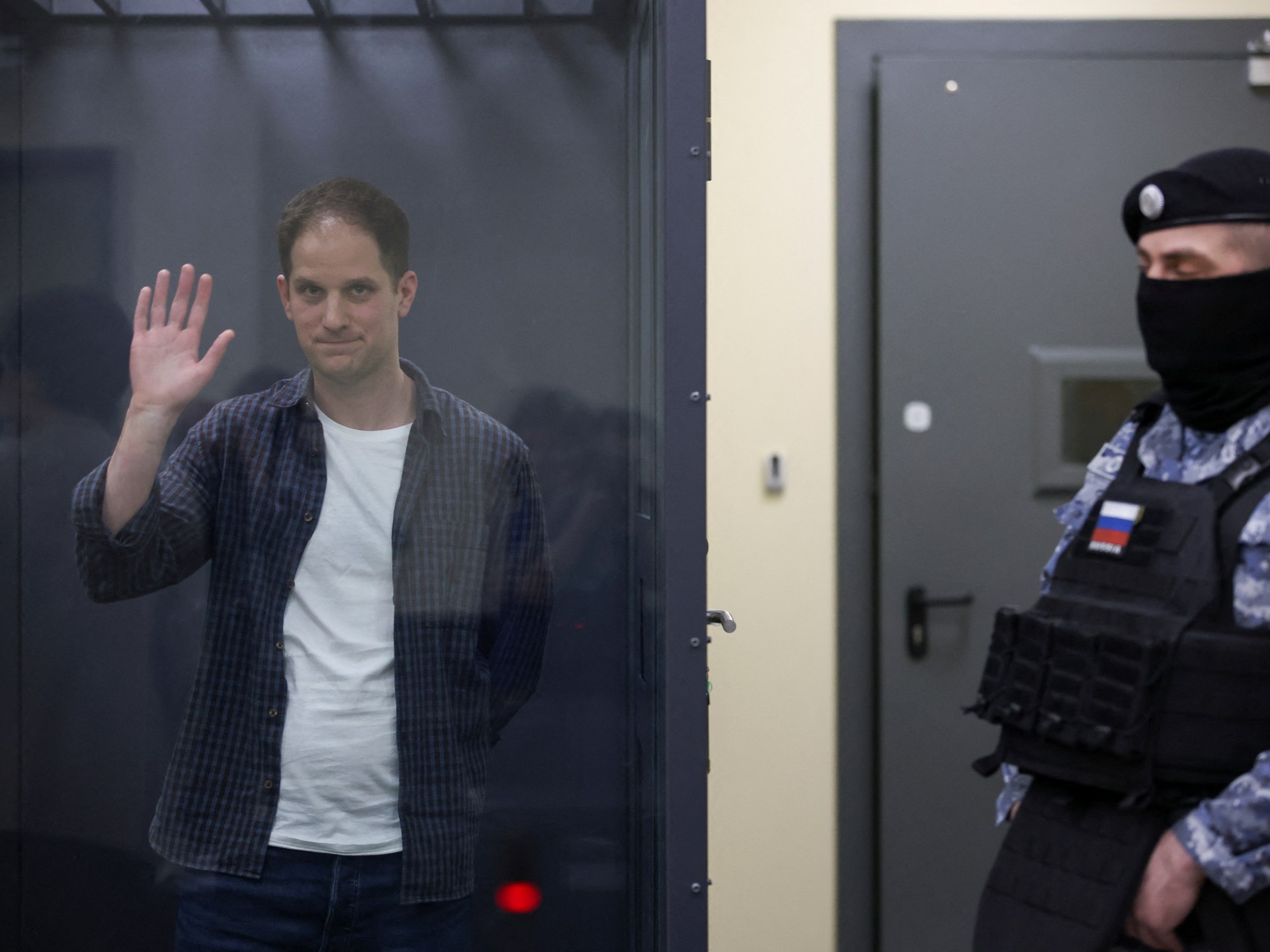Sports
Lindsey Horan just wants to talk soccer

It’s USWNT captain Lindsey Horan’s final morning in the States before a flight back to France to rejoin Lyon, her club team. She’s spending it in a hotel lobby, tucked away at a table, talking to The Athletic for an hour about her time leading a team in the spotlight, how she sees her role during this time of transition, and one thing above all:
“Can we think about the football?”
Horan was speaking almost exactly five months since being named by then-USWNT head coach Vlatko Andonovski as captain of the national team alongside Alex Morgan (Horan has been getting the armband when both are on the field at the same time). The role is the fulfillment of a life goal, but also seems like a natural outcome, given how often, and how intensely, she thinks about the game.
Her first five months in that leadership role were full of notable exits: her team’s from the World Cup, Andonovski’s, and the retirements of Megan Rapinoe and Julie Ertz. It was capped with a big addition: U.S. Soccer’s announced hiring of Emma Hayes as head coach.
Horan, now 29 years old and with 139 senior national team caps under her belt, is part of an in-between camp: too experienced to be a newcomer, and too new to be on the way out. It’s her generation – which also includes Rose Lavelle, Emily Sonnett and others – that must keep the team’s signature fire, that USWNT DNA, burning even as the team undergoes a serious re-think after its worst ever World Cup finish.
GO DEEPER
Vlatko Andonovski interview: ‘A moment there that I was like, ‘Do I really love this game anymore?’
“We have to continue that,” she says of herself and fellow in-betweeners. “You have to be amongst this team for a while to know what the f— that takes… it’s one of the most competitive national teams to be a part of.”
No one on the team is talking about starting from scratch. It’s just that they need more ways to win. More than mentality or fitness levels, more than a never-say-die approach. That’s what Horan said her early conversations with Hayes have been about. And that’s why she wants to talk about football, and how the USWNT can bounce back — not just by playing better, but by thinking more.
“We’ve been so successful for so long in a certain way that we play, that attack and transition,” Horan says. “We’ve had individual brilliance. We’ve had soccer players on the field and real players that want to play and it all kind of meshed together or it would always work out, or our DNA would take us to this place where we come out on top because our mentality was so f—ing good.”
The game is changing, and Horan recognizes this. She praises Portugal’s level of play at the World Cup, the investment into the game in Spain and other European countries, and the high level of up-and-coming U.S. talent (specifically citing 19-year-old San Diego Wave forward Jaedyn Shaw). If there was a theme for Horan and the rest of the USWNT in that final camp of the year, it was a repetitive one: no one actually knows the ceiling of this team.

Horan cited Shaw as an exciting young player for the U.S. (Brad Smith/ISI Photos/USSF/Getty Images for USSF)
“Even in these past few games, you see little glimpses of that, but it’s the final product, continuing to do that throughout the game, getting everyone on the same page, not just four or five players,” she says. “If you can develop that more, and it’s inherent in every single player on the team, you’re looking to play the combinations, all of these things? No idea what this team can do.
“Then you have the mentality aspect on top of it, where if the football is not going well, we know that we can freakin’ go. We have players on the field that are faster, stronger, capable in behind, and we’re gonna gut it out, right? The world is going to be very fearful.”
Those words could cause a stir. In 2019, Ali Krieger suggested the USWNT substitutes could take on and beat multiple other teams at the World Cup, and it was a massive point of contention for a team that got plenty more criticism from across American culture even as it was celebrated for its third consecutive title.
“We have to be one of the most talked about teams,” Horan says. “We’re always in the magnifying glass on every single thing we do or anything we say.”
Individual players can bear the brunt of that magnifying glass just as much as the team can. There’s a clear, though understandable, vein of frustration from Horan over how her own performances are understood, even from the USWNT’s own fanbase. To illustrate her point, Horan brings up that many viewers will take a television commentator’s analysis at face value.
“American soccer fans, most of them aren’t smart,” she says. “They don’t know the game. They don’t understand. (But) it’s getting better and better.”
She takes a brief pause, sensing that those words, too, will cause a stir.
“I’m gonna piss off some people,” she continues, “but the game is growing in the U.S. People are more and more knowledgeable, but so much of the time people take what the commentators say, right? My mom does it!” She breaks into laughter. “My mom says, ‘Julie Foudy said you had such a good game!’ And I’m here, just going, ‘I was f—ing s— today.’”
When playing with Lyon in France, Horan says, things are different.
“From what I’ve heard, people understand my game a little bit more, a sense of my football and the way I play,” she says. “It is the French culture. Everyone watches football. People know football.”
None of that, though, compares to Horan’s experience at the 2023 World Cup. The outside commentary, including from her own former teammate Carli Lloyd, the entrances into stadiums in their custom suits; the tone used in interviews; the body language. Everything was scrutinized. This time, though, the talk was accompanied by bad performances, and bad results.

GO DEEPER
Carli Lloyd’s USWNT criticism a natural extension of her public persona
Horan says she wasn’t bothered by the outside criticism, but noted no one else but the players could understand what it was like to be on that team. Ultimately, she says it felt “perfectly fine” that people would find something to talk about.
“If you’re not backing it up on the field, people are gonna come and talk s— about what you’re doing, where your priorities are,” she says. “Like, ‘Are you getting ready for the game? Are you caring more about this s—?’”

Horan has leaned on Lavelle (left) to help lead a team in transition (Jose Breton/Pics Action/NurPhoto via Getty Images)
Horan, again, comes back to a small, seemingly innocuous detail: The traditional pre-match starting XI photo. In the NWSL, more and more teams have started using the occasion for various hijinks; something that Horan’s European teammates bring up as an example of Americans not taking their business seriously. It’s clear that it gets under her skin, too.
“I want professionalism,” she admits. “Those little things, they really irked me. I don’t think I could do it, and maybe I’m wrong in saying that, I don’t know. It just bothers me. We put so much into this game, and it’s just like a joke sometimes.”
She’s quick to point out she’s not going to be the one who shuts it down if it works for others. That’s not what she’s trying to say. It’s just that, ultimately, for her, it’s about the football.
“We need to get back to the football. The football is the most important thing” Horan says. “So maybe we should knock some of the s— out for now. We need to focus on the game, we need to focus on being the absolute best we can be.”
As captain, Horan can help enact that. It’s a role she’s clearly grown into, even as she has struggled to understand it in the months between Andonovski’s exit and Hayes’ hiring.
Hayes hasn’t officially started yet, and won’t coach in games until after her job as Chelsea’s head coach ends along with the European season in May. But Hayes’ December visit with Horan and the rest of the team helped clarify the process, Horan says. It also gave Horan a chance to open up the lines of communication, to admit that sometimes she didn’t feel like she had full control, that she hadn’t been handed the reins.
“I always felt like I was someone that could really touch on every single player and get the best out of them and try to make them the best that they could be,” Horan says. “I’m not going to be like the rah-rah speeches, all that nonsense. Becky (Sauerbrunn) and me are probably a little similar in that. I’m probably a little more crazy on the field. I want to make sure I’m the leader that I want to be, and no one’s trying to make me something else.”
Before Andonovski gave her the armband — a move made in part because longtime captain Sauerbrunn missed the World Cup due to a lingering foot injury — Horan told him that getting the armband wouldn’t change her, or how players could talk to her. What it would change, she told him, is the tone it would set. She wanted to be a role model.
“I’m not going to be a coach’s captain, I’m going to be a players’ captain,” she told Andonovski. So if that wasn’t what he wanted, then he shouldn’t make her a captain.
Horan has lived up to her word since interim head coach Twila Kilgore stepped in, leaning on Morgan, Lavelle and Sonnett to make them part of the transitional process. She has empowered the team’s relative newcomers, too. The normally-reticent 23-year-old center back Naomi Girma said Horan “encouraged me just to find my voice.”
“A lot of these new young players are going to have big freaking roles, even in this Olympics,” Horan says. “How the hell do we get the best out of them to go put us on the podium? It’s been a crazy place, but this is a really exciting role for me because I’ve felt like this is what I’m meant to do.”
The team has four months until Hayes takes over, and six until the Olympics. The sprint is very much on for this massive group project to re-establish the team at the top, before looking ahead to 2027 and a World Cup that could be hosted at home. Every voice matters to Horan, from Horan to Lavelle to Morgan to Girma to Shaw and beyond.
“We need to be doing everything we possibly can to be improving, to make each other better, holding the standards,” Horan says. “We need to change every bit of culture that we had prior to the last World Cup and going into this Olympics because we need to win. And that starts now.”
(Photo: James Gilbert/Getty Images)

Sports
WNBA great rips media outlets over Angel Reese coverage after flagrant foul on Caitlin Clark: 'Nasty work'
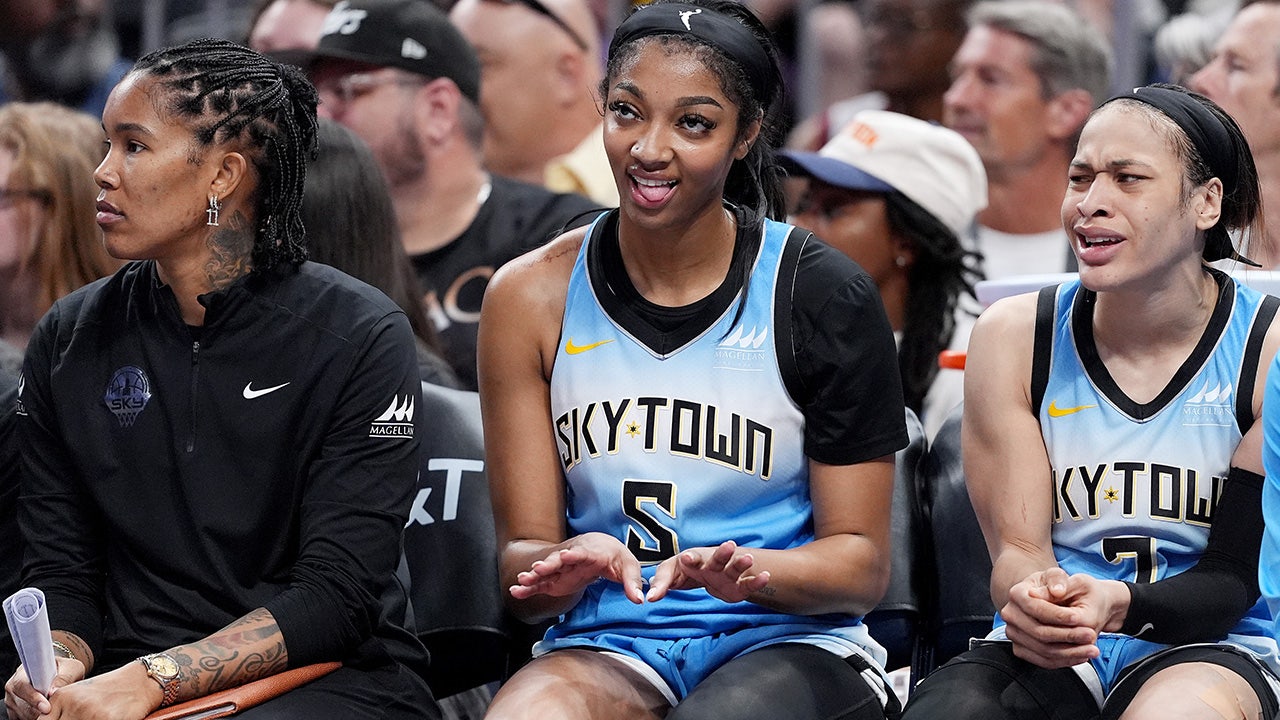
Swin Cash, a three-time WNBA champion and four-time WNBA All-Star, called out the media for its coverage of Angel Reese’s flagrant foul on Caitlin Clark during their matchup Sunday.
Cash wrote that some outlets were doing “nasty work” by only showing the Reese foul, despite it being the major talking point of the Indiana Fever’s win over the Chicago Sky.
Swin Cash participates in MLK Sports Legacy Award and a tour of the National Civil Rights Museum on Jan. 14, 2018 at the National Civil Rights Museum at the Lorraine Motel in Memphis, Tennessee. (Joe Murphy/NBAE via Getty Images)
“To have the only highlight of Angel be that foul is nasty work by these outlets,” Cash, who is currently an executive with the New Orleans Pelicans in the NBA, wrote on X. “U know what you’re doing while also questioning her intent is nonsense! They got it right, it was a flagrant 1 it was called by the refs & the players played on.”
Cash then offered her support for Reese and told the WNBA rookie to keep her head up.
“Smh Keep Pushin & Competing Angel,” the Basketball Hall of Famer added.
Reese swung her arm and hit Clark in the face while trying to go for a block. The Indiana Fever star fell to the ground. The referees upgraded the foul from a common foul to a flagrant-1 after a review.
The play caused a firestorm on social media.
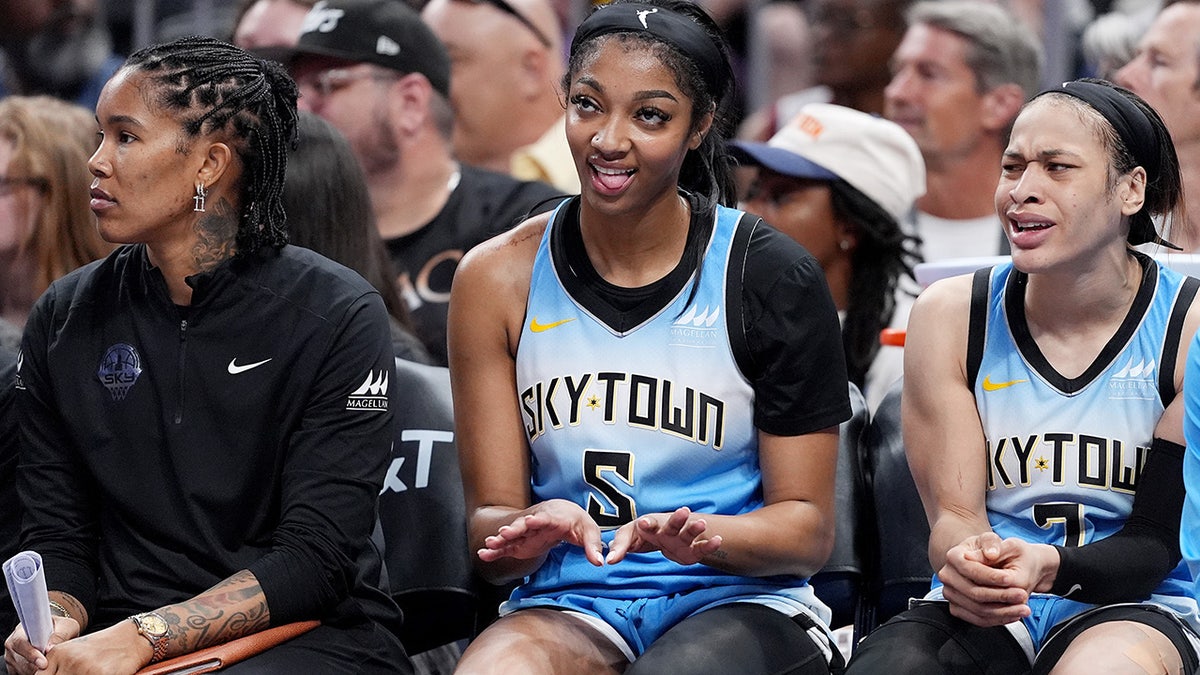
Angel Reese, #5 of the Chicago Sky, reacts to a basket from the bench during the second half against the Indiana Fever at Gainbridge Fieldhouse on June 16, 2024 in Indianapolis. (Emilee Chinn/Getty Images)
ANGEL REESE STRIKES CAITLIN CLARK IN HEAD DURING LAYUP ATTEMPT, RECEIVES FLAGRANT FOUL IN FEVER-SKY REMATCH
“I can’t control the refs, and they affected the game, obviously, a lot tonight,” Reese said after the game. “Y’all are probably going to play that clip like 20 times before Monday.”
Reese finished with 11 points, 13 rebounds and five assists. The Fever won the game, 91-83.
“I think we went up really strong a lot of times and didn’t get a lot of calls,” Reese added. “Going back and looking, I’ve seen a lot of calls that weren’t made, I guess some people get a special whistle.”
Clark downplayed the incident after the game.
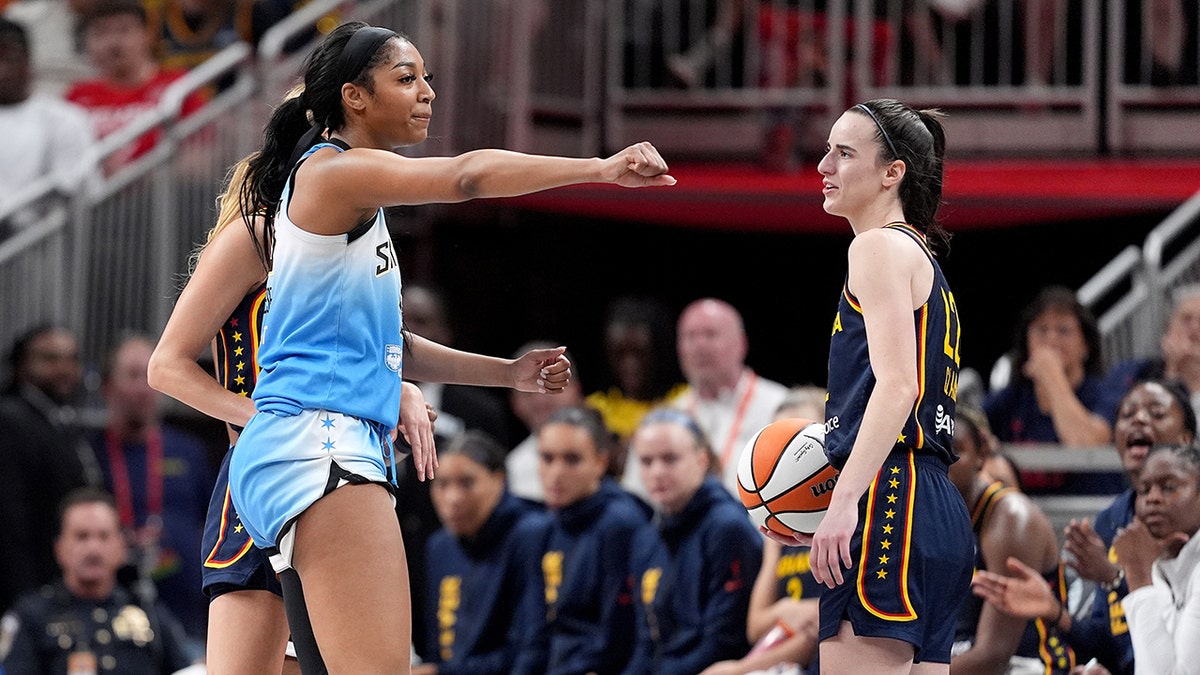
Angel Reese, #5 of the Chicago Sky, reacts after fouling Caitlin Clark, #22 of the Indiana Fever, during the second half at Gainbridge Fieldhouse on June 16, 2024 in Indianapolis. (Emilee Chinn/Getty Images)
“It is what it is, you know, she’s trying to make a play on the ball and get the block,” said Clark, who finished with 23 points, nine assists and eight rebounds. “I mean it happens and then those free throws when you have to shoot with nobody at the line are kind of hard. So I was just focusing on making those free throws.”
The Associated Press contributed to this report.
Follow Fox News Digital’s sports coverage on X and subscribe to the Fox News Sports Huddle newsletter.
Sports
Hernández: Mookie Betts and Yoshinobu Yamamoto injuries create a Dodgers trade deadline dilemma

They were both learning to do something they’d never done before, Mookie Betts playing shortstop full-time and Yoshinobu Yamamoto pitching in the major leagues.
Their respective educations were suddenly paused on Sunday.
Betts broke his left hand when he was struck by a 98-mph fastball during the Dodgers’ 3-0 victory over the Kansas City Royals. Yamamoto was placed on the injured list with a strained rotator cuff.
Manager Dave Roberts said he expected the two players to return this season, but what he neglected to mention was how unlikely they were to come back as the players the Dodgers were hoping they would be.
How can the Dodgers count on Betts to play shortstop at a championship level in October after missing the next several weeks?
How can they rely on Yamamoto to be their No. 2 starter in the playoffs after he broke down just two months into the season?
In both cases, they can’t.
This shouldn’t cost the Dodgers the National League West — they lead the division by eight games — but if they’re serious about contending for a World Series, they’ll have to strike a couple of deals between now and the July 30 trade deadline.
Here’s the problem: There might not be any deals for them to strike.
Willy Adames?
The Brewers are in first place and are unlikely to trade their shortstop, even though he will be a free agent this winter.
Bo Bichette?
The two-time All-Star is having the worst season of his career and the Toronto Blue Jays might only want to move him if they have a fire sale.
The pitching market is equally, if not more, uninspiring.
Corbin Burnes and Dylan Cease, the two best pitchers who were expected to be part of the market, were already traded. Burnes went from the Brewers to the Baltimore Orioles and Cease from the White Sox to the San Diego Padres.
Luis Severino of the New York Mets and Tyler Anderson of the Angels figure to be moved in the coming months, but neither of them is considered better than the pitchers the Dodgers already have.
The Dodgers shouldn’t be looking for quantity, of which they already have plenty. They should be looking for quality.
Dodgers starting pitcher Yoshinobu Yamamoto throws against the Royals on Saturday.
(Gina Ferazzi / Los Angeles Times)
Their lack of high-end pitching cost them in recent postseasons, and the $500-plus million they invested in Yamamoto and Tyler Glasnow was an indirect acknowledgment of that. Yamamoto and Glasnow, however, came with major risks.
Glasnow has never made more than 21 starts in a season or pitched more than 120 innings. He made his 15th start of the season when he pitched seven scoreless innings on Sunday, the most starts he’d ever made consecutively without sustaining an injury.
There were also questions about the durability of Yamamoto, who is listed at 5-foot-10 and pitched only once a week in Japan. Yamamoto rarely threw his slider in his home country, as he believed it led to discomfort in his elbow. He didn’t throw a single slider in any of his first six starts with the Dodgers, but the higher level of competition forced him to adjust.
Yamamoto threw the pitch a season-high 13 times during a recent start against the New York Yankees in which he registered seven scoreless innings. He pushed back his next start by three days. When he finally returned to the mound on Saturday, his fastball velocity was down and he lasted only two innings.
Was the slider responsible for his injury?
“That’s a fair question,” Roberts said.
Does he need the pitch to be effective at this level?
Considering Yamamoto relies heavily on a four-seam fastball, splitter and curveball, Roberts said, “to have something that’s hard and turns to the left, it’s certainly another weapon.”
“But there’s a balance of, if that’s something that causes discomfort, then you gotta think long and hard about it,” Roberts said.
Yamamoto will refrain from throwing for the next couple of weeks, according to Roberts.
“We’ll kind of see where we go from there,” Roberts said.
The timeline for Betts’ return was also undefined, though Betts said he should have a better idea after a scheduled visit on Monday with hand specialist Steven Shin.
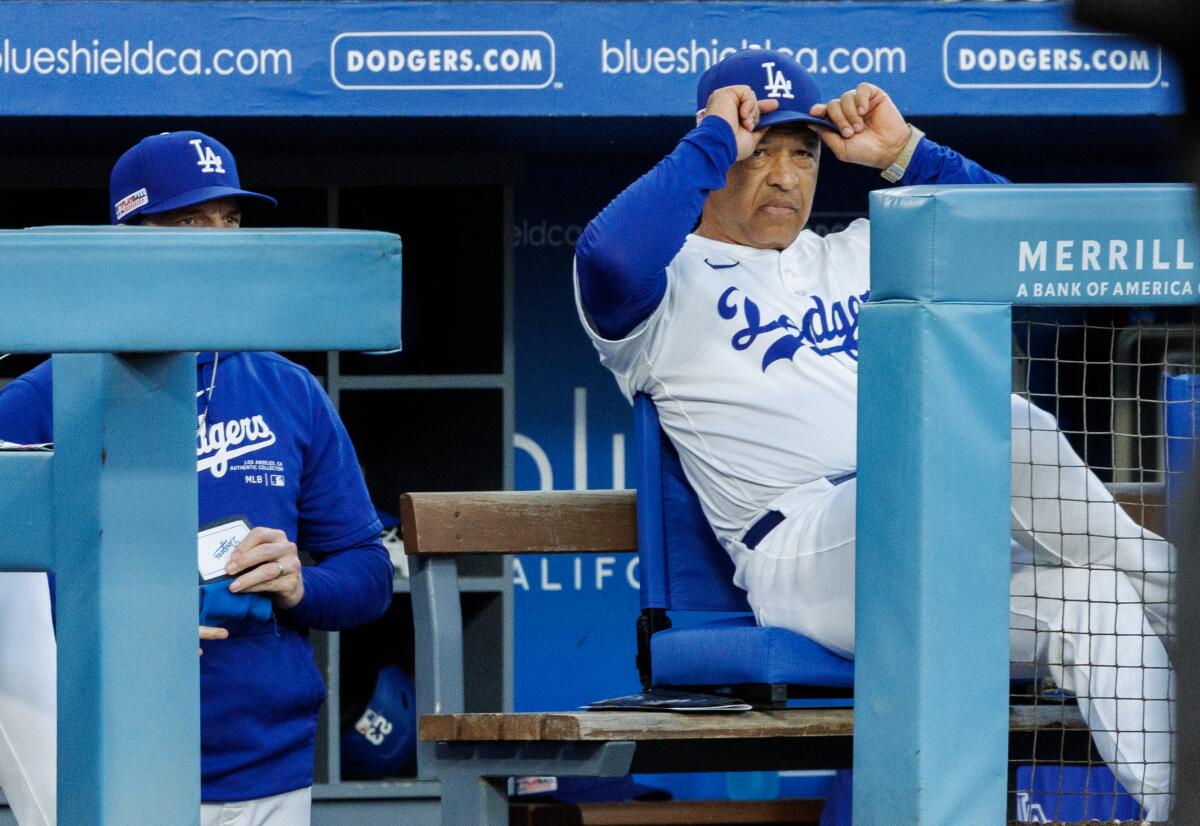
Dodgers manager Dave Roberts pulls down his cap after Blake Treinen walks a Kansas City Royals batter in a Dodgers loss on Saturday.
(Gina Ferazzi / Los Angeles Times)
Shohei Ohtani said in Japanese of watching Betts crumple to the floor after he was struck by a heater delivered by Royals right-hander Dan Altavilla: “I think it was a tough moment for the team as a whole. I think he’s an indispensable player.”
On offense, certainly.
However, on defense, Betts remains a below average shortstop. He last played the position regularly in high school and didn’t move there this year until shortly before opening day. Betts has tried to make up for his experience by taking grounders before almost every game.
Every game Betts misses will cost him a chance to make up the ground he lost while playing right field and second base during the previous 10 years of his major league career.
“While praying for his return,” Ohtani said, “I’d like for us to cover for him as a team.”
Ohtani didn’t say this, but the responsibility to do so isn’t exclusive to the players. Dodgers president of baseball operations Andrew Friedman and the small army of assistants who make up the front office share the burden. They’ll have to find players in a down market.
Sports
Phillies manager Rob Thomson's screaming match with umpire leads to ejection in bizarre scene
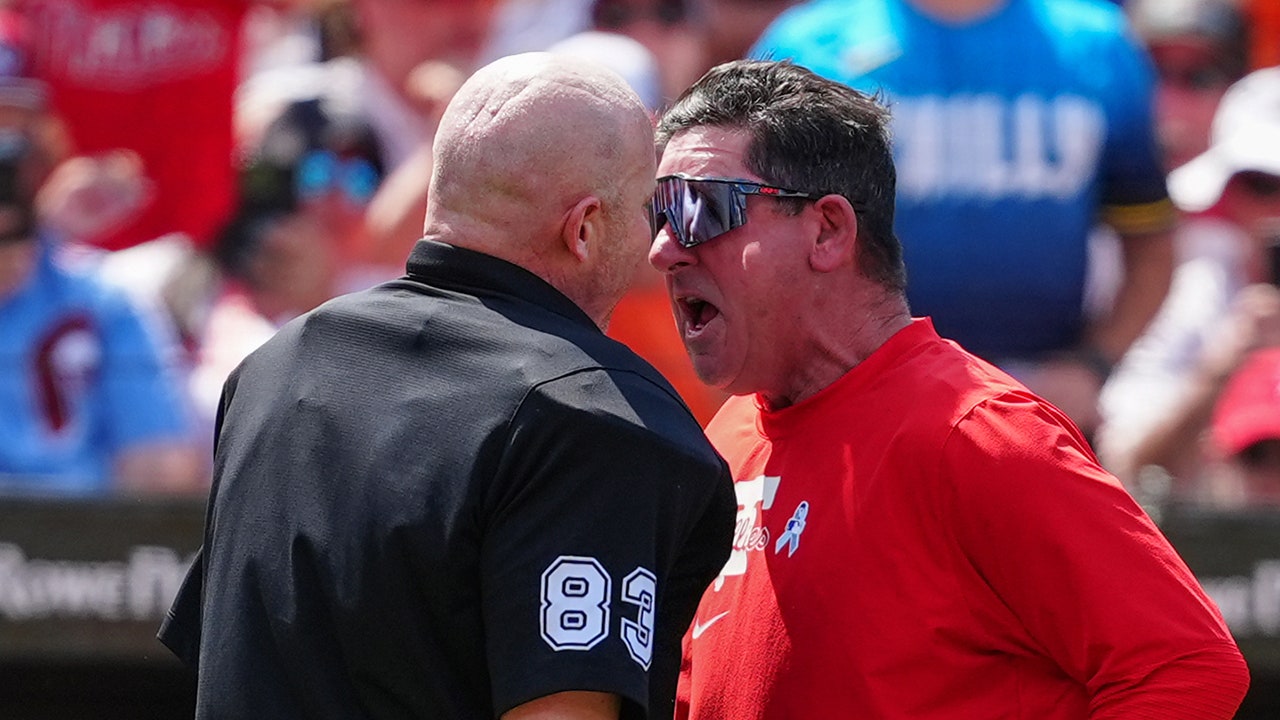
Philadelphia Phillies manager Rob Thomson and umpire Mike Estabrook got into a wild screaming match that resulted in an ejection on Father’s Day against the Baltimore Orioles.
The Phillies weren’t doing well in the top of the sixth inning as the O’s held an 8-2 lead at their home, Camden Yards, and it didn’t help matters when Estabrook reversed a call initially ruled a hit-by-pitch on the Phillies’ Garrett Stubbs. He did so after conversing with his fellow umpires on the field.
Before Estabrook reversed the call and brought Stubbs back to home plate, Thomson was already fuming about his strike zone behind home plate on the day.
Home plate umpire Mike Estabrook ejects Philadelphia Phillies manager Rob Thomson during the sixth inning against the Baltimore Orioles at Oriole Park at Camden Yards. (Gregory Fisher-USA TODAY Sports)
When Thomson emerged from the dugout and wanted an explanation from Estabrook, that’s when things got heated. The tipping point came when Thomson, who was clearly barking at Estabrook, pointed his finger at him and just missed poking him in the chest as he yelled.
VIEW THE MOMENT ON X
That resulted in Estabrook turning around fast and tossing Thomson from the game, which sent the veteran manager into a frenzy.
But what we normally see in these moments is the manager letting off steam and the umpire simply taking it. Estabrook thought differently as he started to give it right back to Thomson in a wild scene.
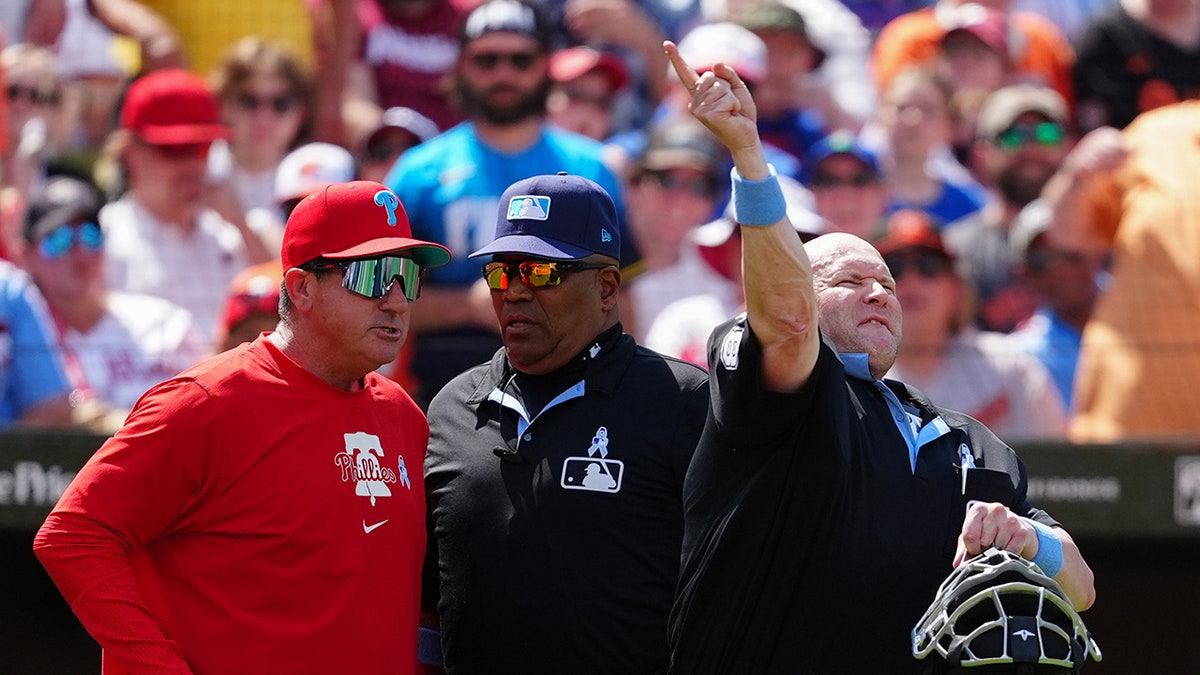
Home plate umpire Mike Estabrook ejects Philadelphia Phillies manager Rob Thomson during the sixth inning against the Baltimore Orioles at Oriole Park at Camden Yards. (Gregory Fisher-USA TODAY Sports)
Umpire Laz Diaz let the argument unfold a bit before stepping in and sending Thomson to the clubhouse.
After things settled down, the play was brought to a replay review, and Estabrook bringing Stubbs back to hit was the right call because the ball did not hit him.
The Phillies went on to lose, 8-3, which marked their fourth loss in the last six games.
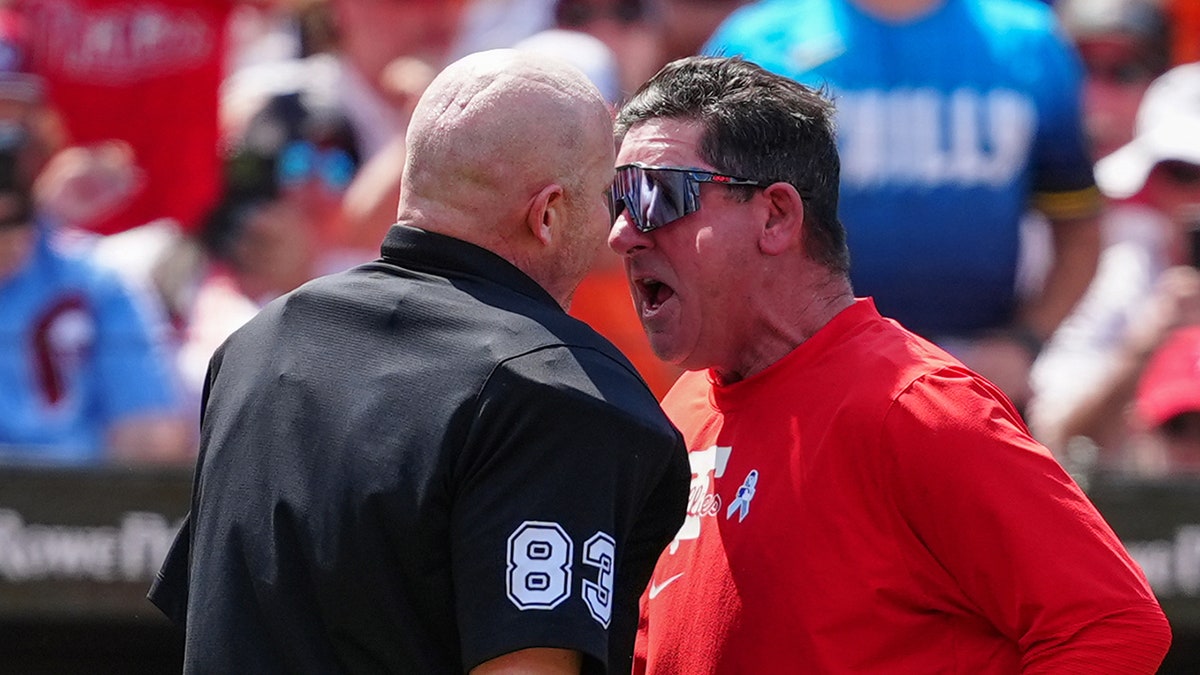
Home plate umpire Mike Estabrook argues with Philadelphia Phillies manager Rob Thomson during the sixth inning against the Baltimore Orioles at Oriole Park at Camden Yards. (Gregory Fisher-USA TODAY Sports)
Still, the Phillies own the best record in the National League even with the loss. They’re 47-24 on the season, though they’ve been worse on the road than at home, owning a 20-14 record in away games.
Follow Fox News Digital’s sports coverage on X and subscribe to the Fox News Sports Huddle newsletter.
-

 News1 week ago
News1 week agoWould President Biden’s asylum restrictions work? It’s a short-term fix, analysts say
-

 World1 week ago
World1 week agoDozens killed near Sudan’s capital as UN warns of soaring displacement
-

 News1 week ago
News1 week agoRead Justice Clarence Thomas’s Financial Disclosures for 2023
-

 Politics1 week ago
Politics1 week agoNewson, Dem leaders try to negotiate Prop 47 reform off California ballots, as GOP wants to let voters decide
-

 World1 week ago
World1 week ago‘Bloody policies’: Bodies of 11 refugees and migrants recovered off Libya
-

 Politics1 week ago
Politics1 week agoGun group vows to 'defend' Trump's concealed carry license after conviction
-

 Politics1 week ago
Politics1 week agoShould Trump have confidence in his lawyers? Legal experts weigh in
-

 Politics6 days ago
Politics6 days agoGOP releases Jan. 6 clip of Pelosi saying 'I take responsibility' as she discussed National Guard absence









